Analysis of Corporate Social Responsibility at Thai Beverage (ThaiBev)
VerifiedAdded on 2022/09/22
|22
|5586
|26
Report
AI Summary
This report examines the corporate social responsibility (CSR) strategies of Thai Beverage Company Limited (ThaiBev). It analyzes ThaiBev's CSR activities, including social, environmental, and economic responsibilities. The report explores the company's commitment to ethical practices, its use of CSR to enhance its image, and its application of CSR models such as stakeholder theory, Carroll's pyramid, and the three-domain model. It discusses ThaiBev's approach to social, environmental, and economic responsibility, highlighting its efforts to support distributors, promote ethical business practices, and engage in community development. The report provides recommendations for improving CSR communication, selecting social issues, and making partnerships with the public. Overall, the report emphasizes the importance of CSR in promoting a positive image and achieving long-term sustainability for ThaiBev, drawing from the company's establishment in 2003 and its strong leadership.
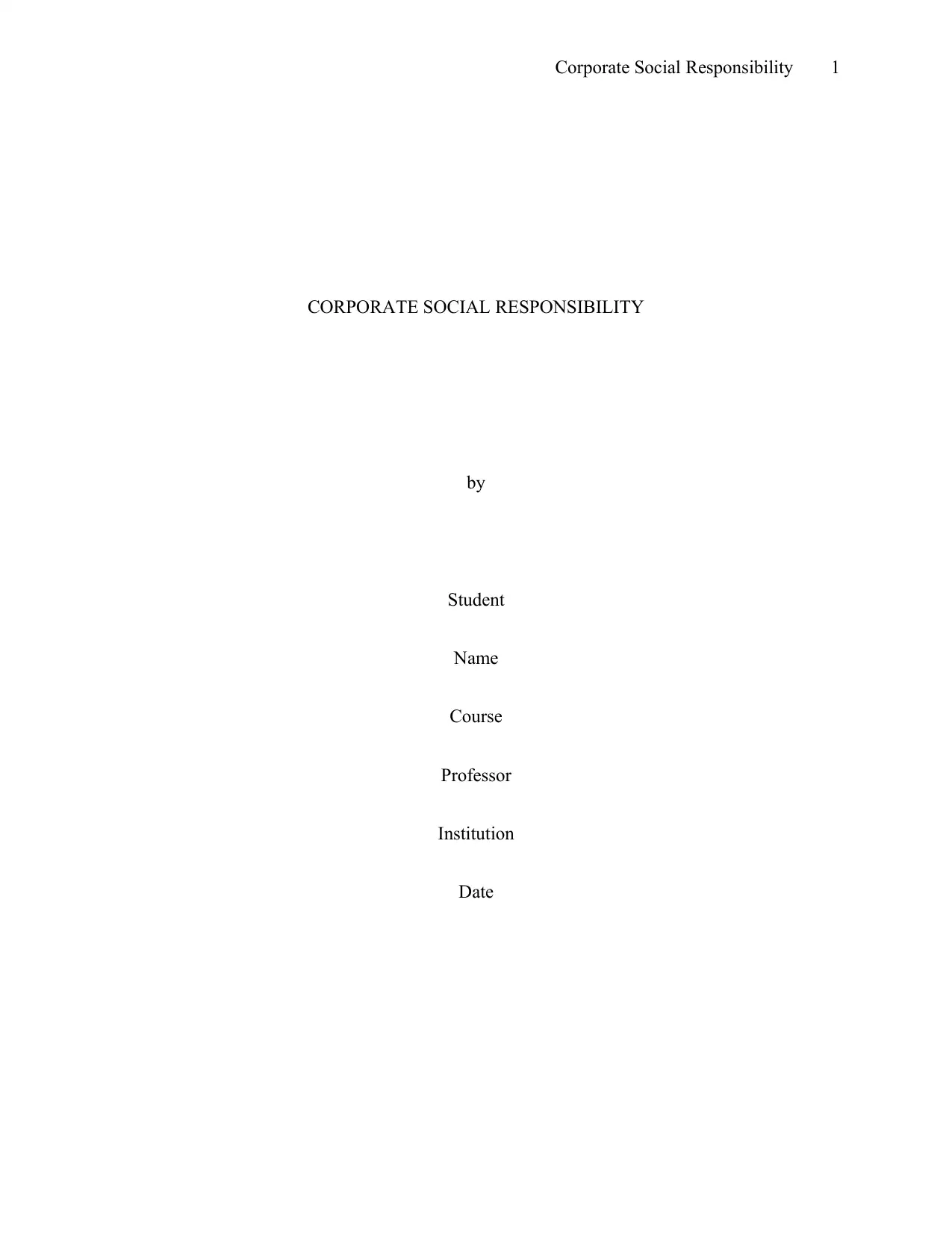
Corporate Social Responsibility 1
CORPORATE SOCIAL RESPONSIBILITY
by
Student
Name
Course
Professor
Institution
Date
CORPORATE SOCIAL RESPONSIBILITY
by
Student
Name
Course
Professor
Institution
Date
Paraphrase This Document
Need a fresh take? Get an instant paraphrase of this document with our AI Paraphraser
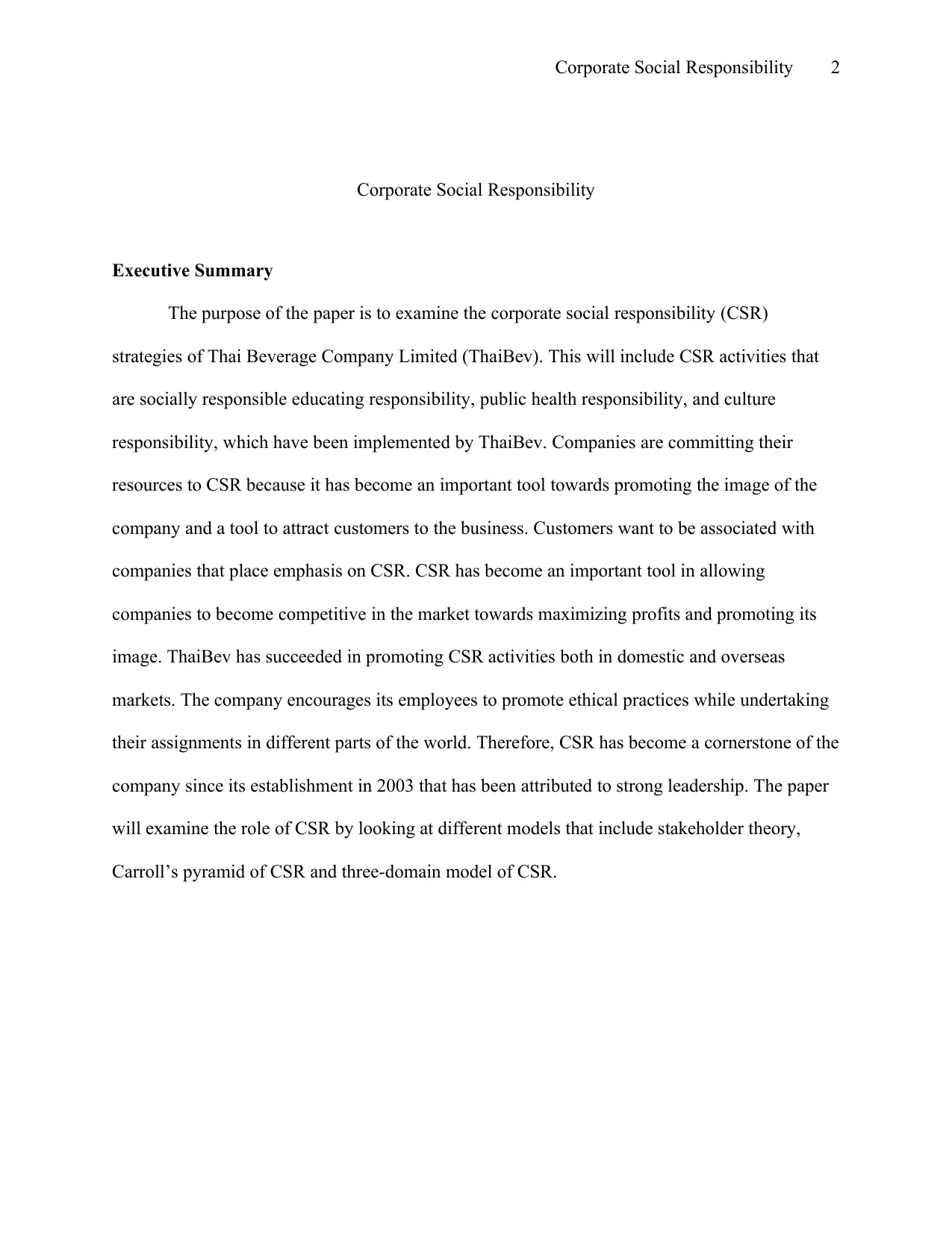
Corporate Social Responsibility 2
Corporate Social Responsibility
Executive Summary
The purpose of the paper is to examine the corporate social responsibility (CSR)
strategies of Thai Beverage Company Limited (ThaiBev). This will include CSR activities that
are socially responsible educating responsibility, public health responsibility, and culture
responsibility, which have been implemented by ThaiBev. Companies are committing their
resources to CSR because it has become an important tool towards promoting the image of the
company and a tool to attract customers to the business. Customers want to be associated with
companies that place emphasis on CSR. CSR has become an important tool in allowing
companies to become competitive in the market towards maximizing profits and promoting its
image. ThaiBev has succeeded in promoting CSR activities both in domestic and overseas
markets. The company encourages its employees to promote ethical practices while undertaking
their assignments in different parts of the world. Therefore, CSR has become a cornerstone of the
company since its establishment in 2003 that has been attributed to strong leadership. The paper
will examine the role of CSR by looking at different models that include stakeholder theory,
Carroll’s pyramid of CSR and three-domain model of CSR.
Corporate Social Responsibility
Executive Summary
The purpose of the paper is to examine the corporate social responsibility (CSR)
strategies of Thai Beverage Company Limited (ThaiBev). This will include CSR activities that
are socially responsible educating responsibility, public health responsibility, and culture
responsibility, which have been implemented by ThaiBev. Companies are committing their
resources to CSR because it has become an important tool towards promoting the image of the
company and a tool to attract customers to the business. Customers want to be associated with
companies that place emphasis on CSR. CSR has become an important tool in allowing
companies to become competitive in the market towards maximizing profits and promoting its
image. ThaiBev has succeeded in promoting CSR activities both in domestic and overseas
markets. The company encourages its employees to promote ethical practices while undertaking
their assignments in different parts of the world. Therefore, CSR has become a cornerstone of the
company since its establishment in 2003 that has been attributed to strong leadership. The paper
will examine the role of CSR by looking at different models that include stakeholder theory,
Carroll’s pyramid of CSR and three-domain model of CSR.
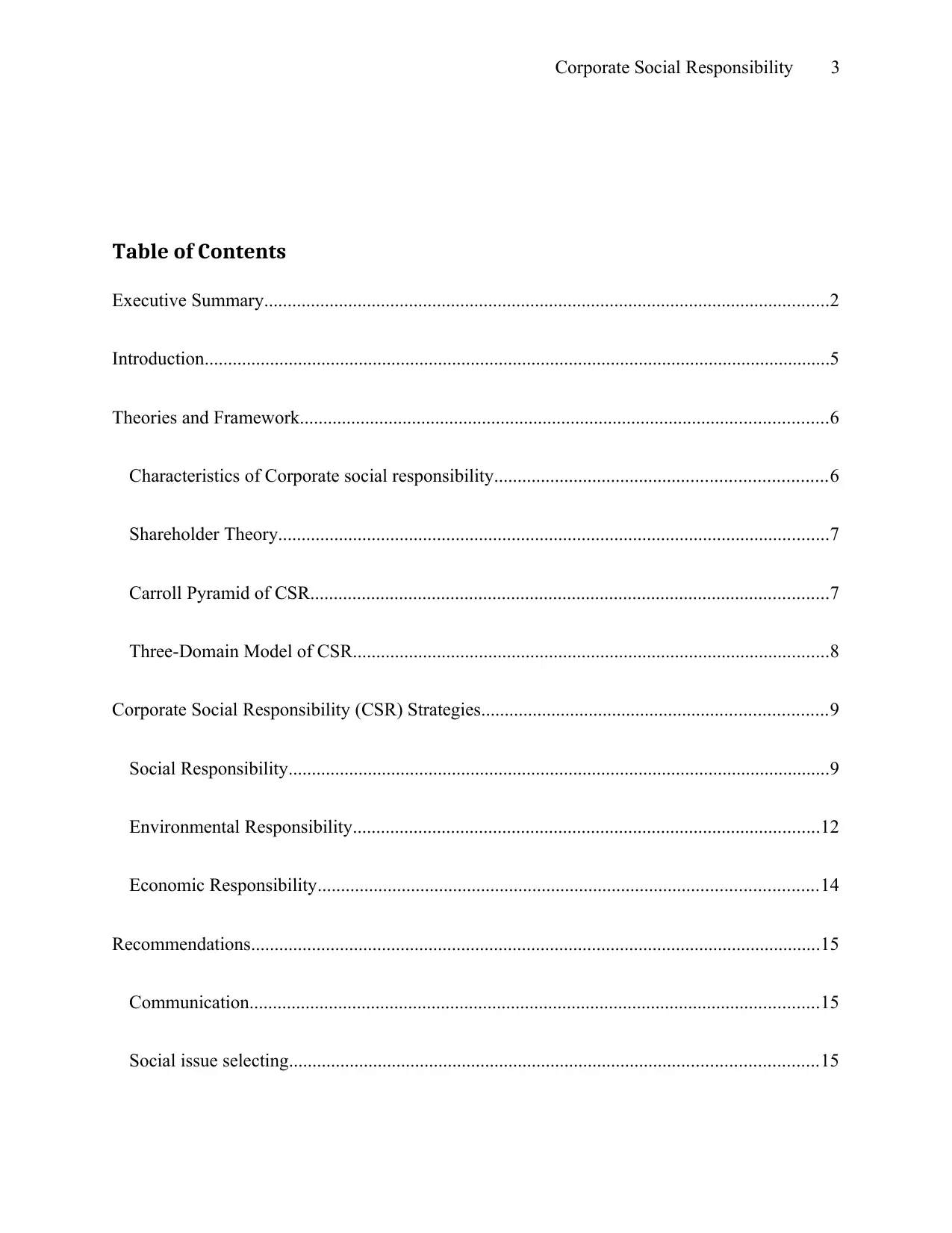
Corporate Social Responsibility 3
Table of Contents
Executive Summary.........................................................................................................................2
Introduction......................................................................................................................................5
Theories and Framework.................................................................................................................6
Characteristics of Corporate social responsibility.......................................................................6
Shareholder Theory......................................................................................................................7
Carroll Pyramid of CSR...............................................................................................................7
Three-Domain Model of CSR......................................................................................................8
Corporate Social Responsibility (CSR) Strategies..........................................................................9
Social Responsibility....................................................................................................................9
Environmental Responsibility....................................................................................................12
Economic Responsibility...........................................................................................................14
Recommendations..........................................................................................................................15
Communication..........................................................................................................................15
Social issue selecting.................................................................................................................15
Table of Contents
Executive Summary.........................................................................................................................2
Introduction......................................................................................................................................5
Theories and Framework.................................................................................................................6
Characteristics of Corporate social responsibility.......................................................................6
Shareholder Theory......................................................................................................................7
Carroll Pyramid of CSR...............................................................................................................7
Three-Domain Model of CSR......................................................................................................8
Corporate Social Responsibility (CSR) Strategies..........................................................................9
Social Responsibility....................................................................................................................9
Environmental Responsibility....................................................................................................12
Economic Responsibility...........................................................................................................14
Recommendations..........................................................................................................................15
Communication..........................................................................................................................15
Social issue selecting.................................................................................................................15
⊘ This is a preview!⊘
Do you want full access?
Subscribe today to unlock all pages.

Trusted by 1+ million students worldwide

Corporate Social Responsibility 4
To make partnership with the public..........................................................................................16
Increase CSR activities..............................................................................................................16
Conclusions....................................................................................................................................16
References......................................................................................................................................18
To make partnership with the public..........................................................................................16
Increase CSR activities..............................................................................................................16
Conclusions....................................................................................................................................16
References......................................................................................................................................18
Paraphrase This Document
Need a fresh take? Get an instant paraphrase of this document with our AI Paraphraser
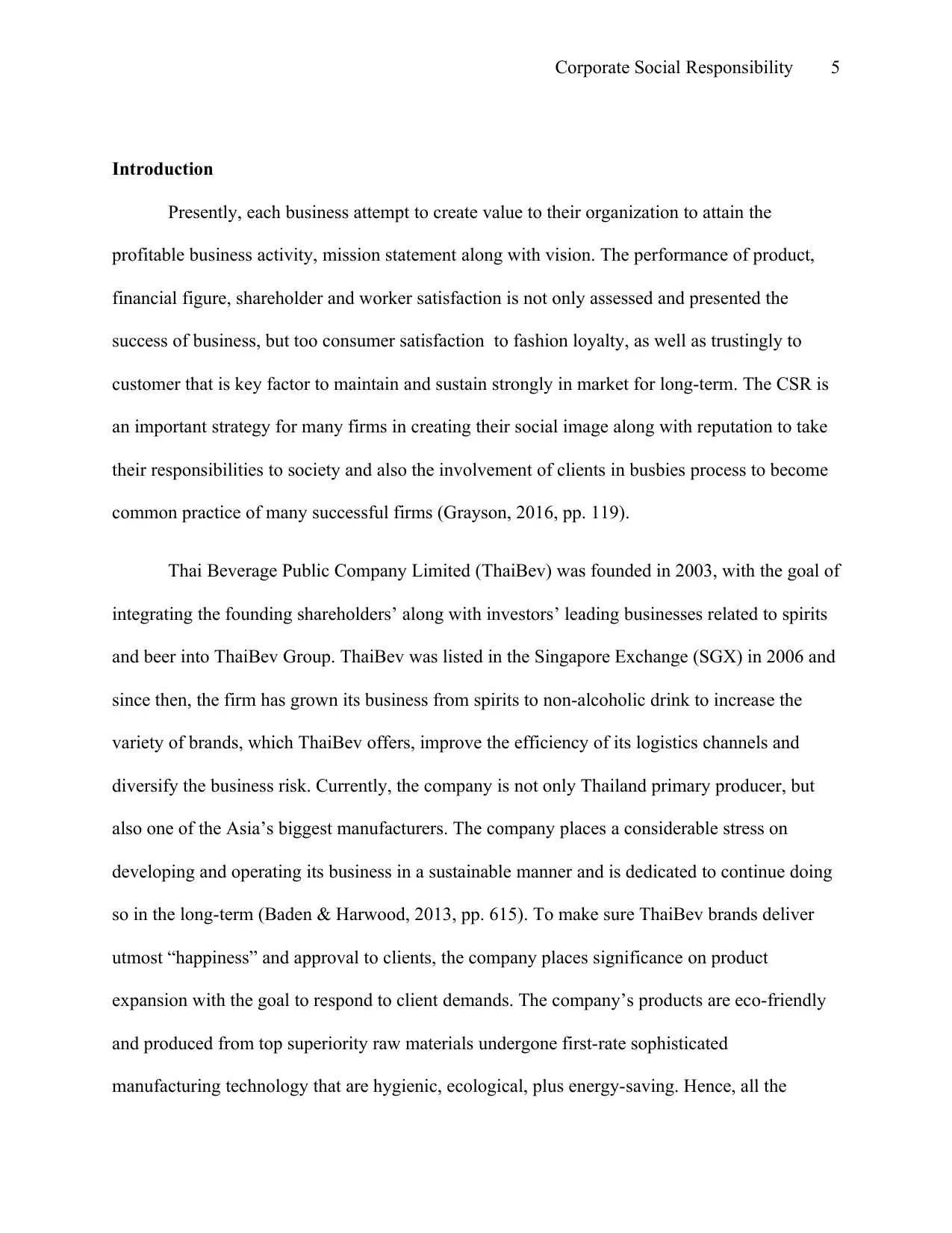
Corporate Social Responsibility 5
Introduction
Presently, each business attempt to create value to their organization to attain the
profitable business activity, mission statement along with vision. The performance of product,
financial figure, shareholder and worker satisfaction is not only assessed and presented the
success of business, but too consumer satisfaction to fashion loyalty, as well as trustingly to
customer that is key factor to maintain and sustain strongly in market for long-term. The CSR is
an important strategy for many firms in creating their social image along with reputation to take
their responsibilities to society and also the involvement of clients in busbies process to become
common practice of many successful firms (Grayson, 2016, pp. 119).
Thai Beverage Public Company Limited (ThaiBev) was founded in 2003, with the goal of
integrating the founding shareholders’ along with investors’ leading businesses related to spirits
and beer into ThaiBev Group. ThaiBev was listed in the Singapore Exchange (SGX) in 2006 and
since then, the firm has grown its business from spirits to non-alcoholic drink to increase the
variety of brands, which ThaiBev offers, improve the efficiency of its logistics channels and
diversify the business risk. Currently, the company is not only Thailand primary producer, but
also one of the Asia’s biggest manufacturers. The company places a considerable stress on
developing and operating its business in a sustainable manner and is dedicated to continue doing
so in the long-term (Baden & Harwood, 2013, pp. 615). To make sure ThaiBev brands deliver
utmost “happiness” and approval to clients, the company places significance on product
expansion with the goal to respond to client demands. The company’s products are eco-friendly
and produced from top superiority raw materials undergone first-rate sophisticated
manufacturing technology that are hygienic, ecological, plus energy-saving. Hence, all the
Introduction
Presently, each business attempt to create value to their organization to attain the
profitable business activity, mission statement along with vision. The performance of product,
financial figure, shareholder and worker satisfaction is not only assessed and presented the
success of business, but too consumer satisfaction to fashion loyalty, as well as trustingly to
customer that is key factor to maintain and sustain strongly in market for long-term. The CSR is
an important strategy for many firms in creating their social image along with reputation to take
their responsibilities to society and also the involvement of clients in busbies process to become
common practice of many successful firms (Grayson, 2016, pp. 119).
Thai Beverage Public Company Limited (ThaiBev) was founded in 2003, with the goal of
integrating the founding shareholders’ along with investors’ leading businesses related to spirits
and beer into ThaiBev Group. ThaiBev was listed in the Singapore Exchange (SGX) in 2006 and
since then, the firm has grown its business from spirits to non-alcoholic drink to increase the
variety of brands, which ThaiBev offers, improve the efficiency of its logistics channels and
diversify the business risk. Currently, the company is not only Thailand primary producer, but
also one of the Asia’s biggest manufacturers. The company places a considerable stress on
developing and operating its business in a sustainable manner and is dedicated to continue doing
so in the long-term (Baden & Harwood, 2013, pp. 615). To make sure ThaiBev brands deliver
utmost “happiness” and approval to clients, the company places significance on product
expansion with the goal to respond to client demands. The company’s products are eco-friendly
and produced from top superiority raw materials undergone first-rate sophisticated
manufacturing technology that are hygienic, ecological, plus energy-saving. Hence, all the
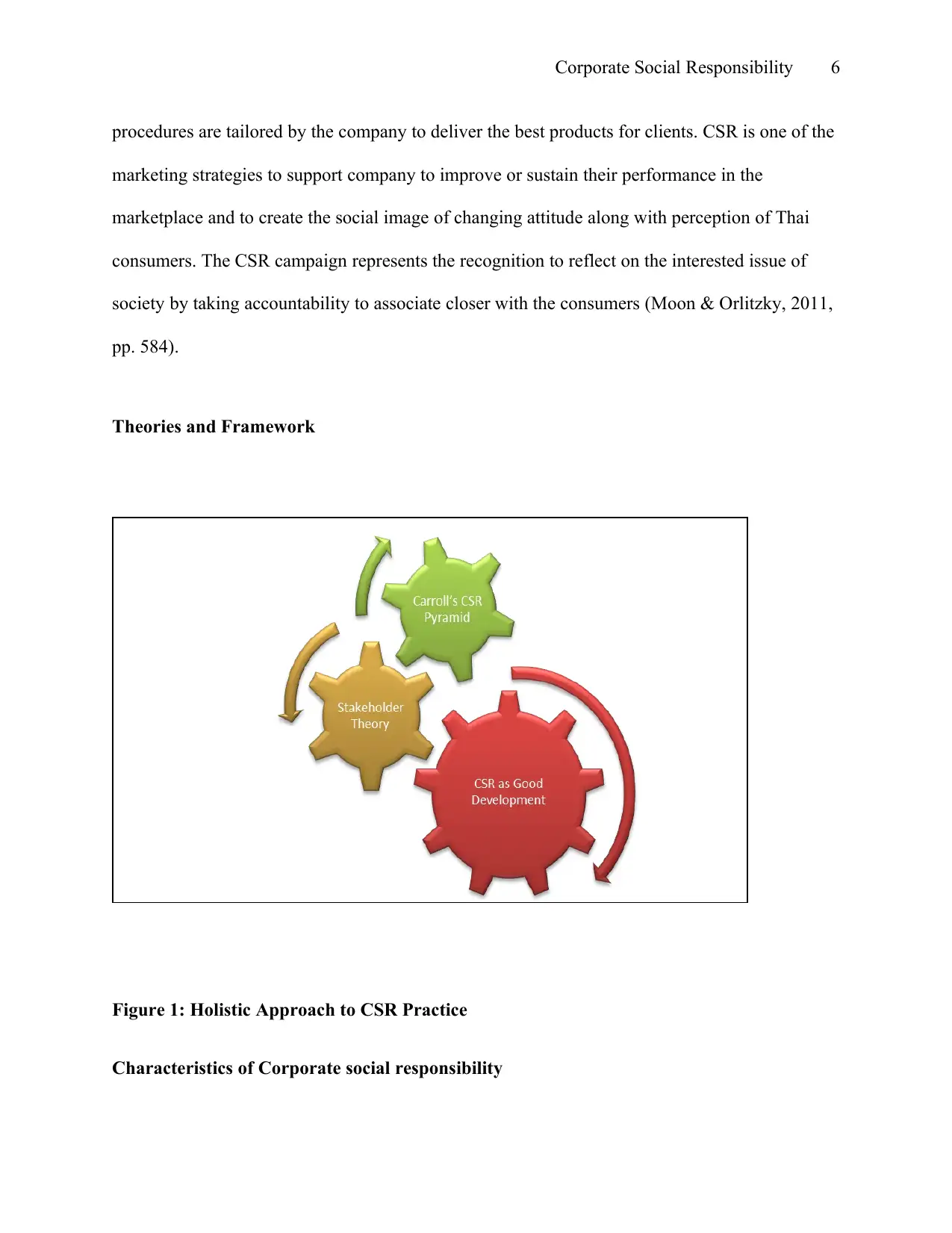
Corporate Social Responsibility 6
procedures are tailored by the company to deliver the best products for clients. CSR is one of the
marketing strategies to support company to improve or sustain their performance in the
marketplace and to create the social image of changing attitude along with perception of Thai
consumers. The CSR campaign represents the recognition to reflect on the interested issue of
society by taking accountability to associate closer with the consumers (Moon & Orlitzky, 2011,
pp. 584).
Theories and Framework
Figure 1: Holistic Approach to CSR Practice
Characteristics of Corporate social responsibility
procedures are tailored by the company to deliver the best products for clients. CSR is one of the
marketing strategies to support company to improve or sustain their performance in the
marketplace and to create the social image of changing attitude along with perception of Thai
consumers. The CSR campaign represents the recognition to reflect on the interested issue of
society by taking accountability to associate closer with the consumers (Moon & Orlitzky, 2011,
pp. 584).
Theories and Framework
Figure 1: Holistic Approach to CSR Practice
Characteristics of Corporate social responsibility
⊘ This is a preview!⊘
Do you want full access?
Subscribe today to unlock all pages.

Trusted by 1+ million students worldwide
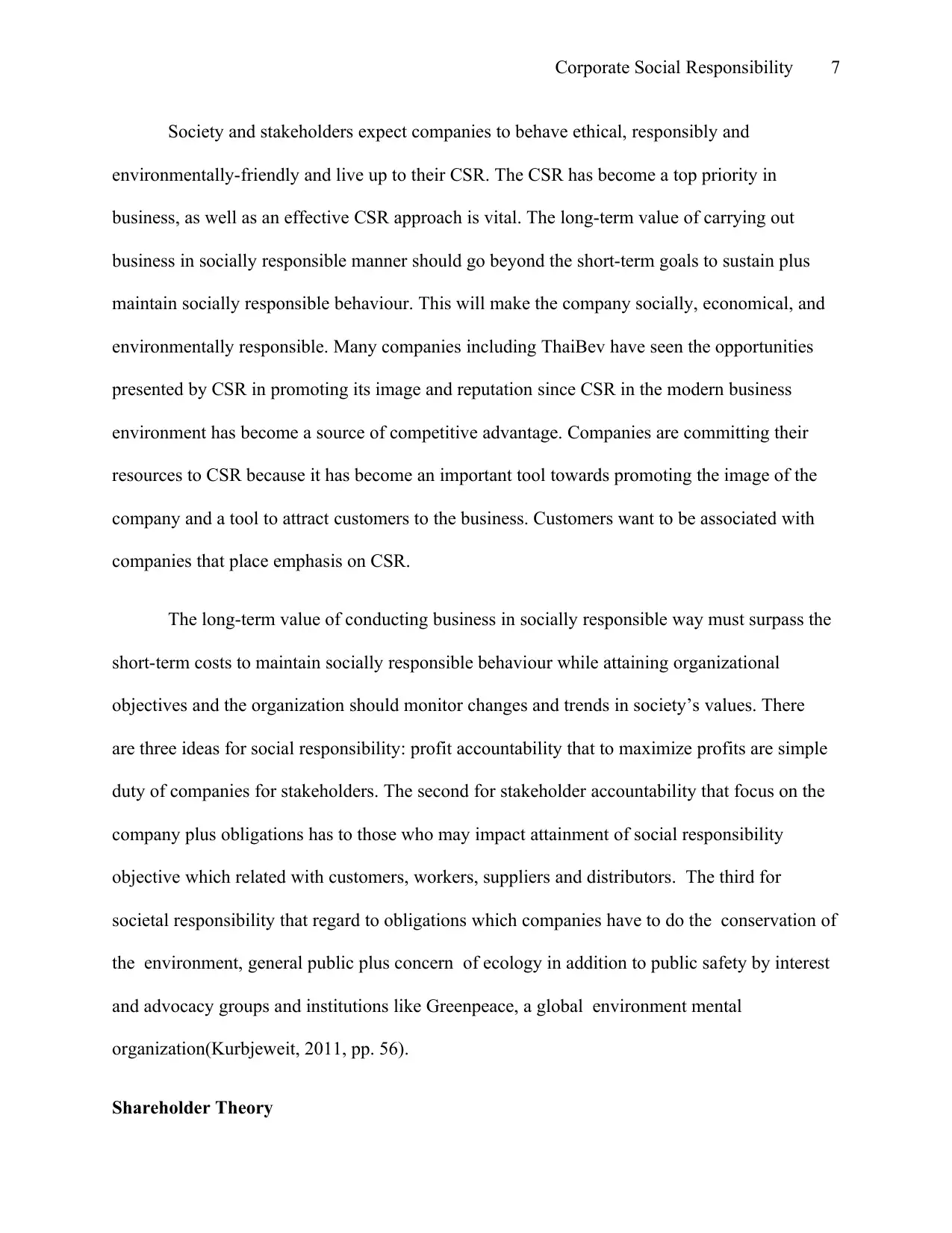
Corporate Social Responsibility 7
Society and stakeholders expect companies to behave ethical, responsibly and
environmentally-friendly and live up to their CSR. The CSR has become a top priority in
business, as well as an effective CSR approach is vital. The long-term value of carrying out
business in socially responsible manner should go beyond the short-term goals to sustain plus
maintain socially responsible behaviour. This will make the company socially, economical, and
environmentally responsible. Many companies including ThaiBev have seen the opportunities
presented by CSR in promoting its image and reputation since CSR in the modern business
environment has become a source of competitive advantage. Companies are committing their
resources to CSR because it has become an important tool towards promoting the image of the
company and a tool to attract customers to the business. Customers want to be associated with
companies that place emphasis on CSR.
The long-term value of conducting business in socially responsible way must surpass the
short-term costs to maintain socially responsible behaviour while attaining organizational
objectives and the organization should monitor changes and trends in society’s values. There
are three ideas for social responsibility: profit accountability that to maximize profits are simple
duty of companies for stakeholders. The second for stakeholder accountability that focus on the
company plus obligations has to those who may impact attainment of social responsibility
objective which related with customers, workers, suppliers and distributors. The third for
societal responsibility that regard to obligations which companies have to do the conservation of
the environment, general public plus concern of ecology in addition to public safety by interest
and advocacy groups and institutions like Greenpeace, a global environment mental
organization(Kurbjeweit, 2011, pp. 56).
Shareholder Theory
Society and stakeholders expect companies to behave ethical, responsibly and
environmentally-friendly and live up to their CSR. The CSR has become a top priority in
business, as well as an effective CSR approach is vital. The long-term value of carrying out
business in socially responsible manner should go beyond the short-term goals to sustain plus
maintain socially responsible behaviour. This will make the company socially, economical, and
environmentally responsible. Many companies including ThaiBev have seen the opportunities
presented by CSR in promoting its image and reputation since CSR in the modern business
environment has become a source of competitive advantage. Companies are committing their
resources to CSR because it has become an important tool towards promoting the image of the
company and a tool to attract customers to the business. Customers want to be associated with
companies that place emphasis on CSR.
The long-term value of conducting business in socially responsible way must surpass the
short-term costs to maintain socially responsible behaviour while attaining organizational
objectives and the organization should monitor changes and trends in society’s values. There
are three ideas for social responsibility: profit accountability that to maximize profits are simple
duty of companies for stakeholders. The second for stakeholder accountability that focus on the
company plus obligations has to those who may impact attainment of social responsibility
objective which related with customers, workers, suppliers and distributors. The third for
societal responsibility that regard to obligations which companies have to do the conservation of
the environment, general public plus concern of ecology in addition to public safety by interest
and advocacy groups and institutions like Greenpeace, a global environment mental
organization(Kurbjeweit, 2011, pp. 56).
Shareholder Theory
Paraphrase This Document
Need a fresh take? Get an instant paraphrase of this document with our AI Paraphraser
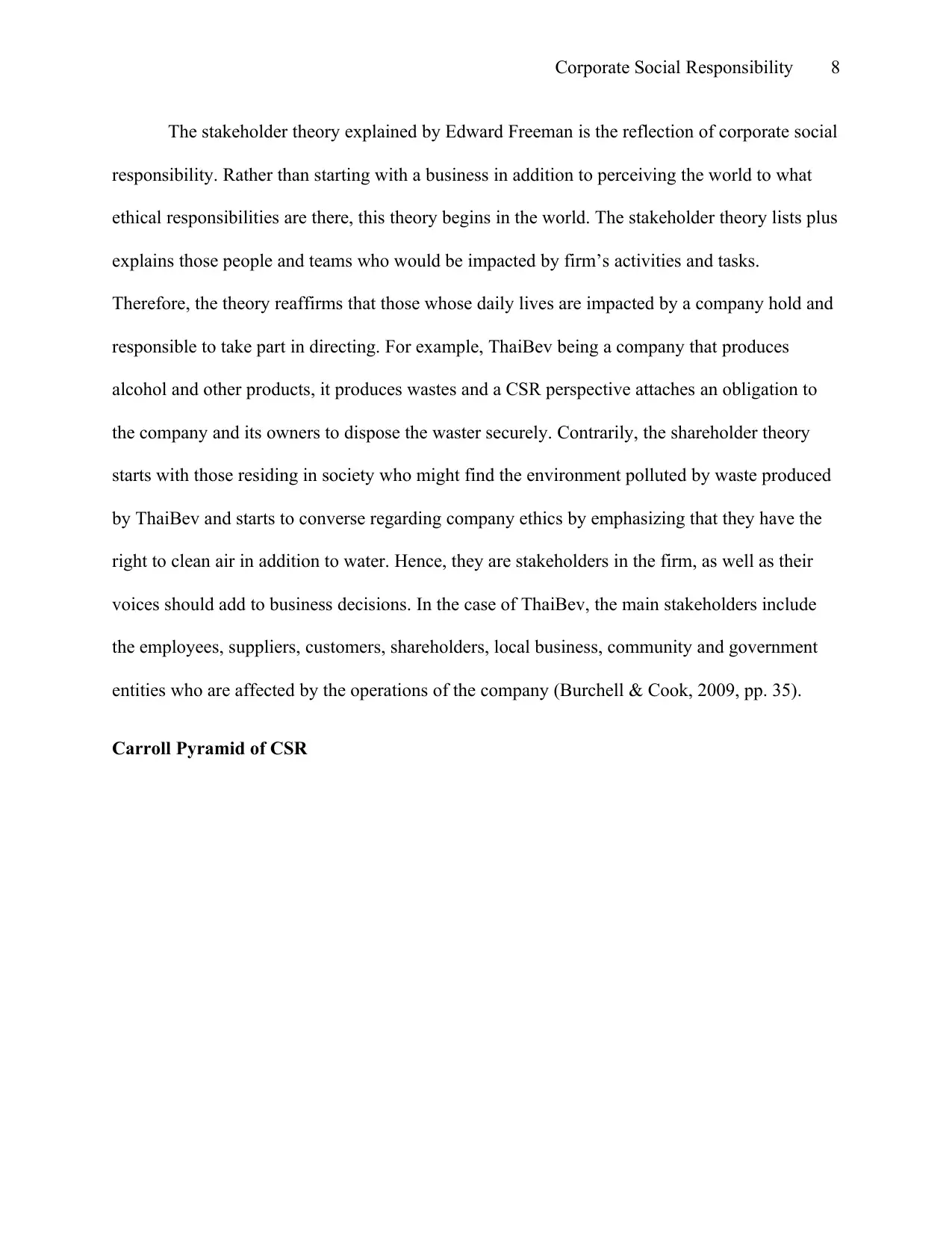
Corporate Social Responsibility 8
The stakeholder theory explained by Edward Freeman is the reflection of corporate social
responsibility. Rather than starting with a business in addition to perceiving the world to what
ethical responsibilities are there, this theory begins in the world. The stakeholder theory lists plus
explains those people and teams who would be impacted by firm’s activities and tasks.
Therefore, the theory reaffirms that those whose daily lives are impacted by a company hold and
responsible to take part in directing. For example, ThaiBev being a company that produces
alcohol and other products, it produces wastes and a CSR perspective attaches an obligation to
the company and its owners to dispose the waster securely. Contrarily, the shareholder theory
starts with those residing in society who might find the environment polluted by waste produced
by ThaiBev and starts to converse regarding company ethics by emphasizing that they have the
right to clean air in addition to water. Hence, they are stakeholders in the firm, as well as their
voices should add to business decisions. In the case of ThaiBev, the main stakeholders include
the employees, suppliers, customers, shareholders, local business, community and government
entities who are affected by the operations of the company (Burchell & Cook, 2009, pp. 35).
Carroll Pyramid of CSR
The stakeholder theory explained by Edward Freeman is the reflection of corporate social
responsibility. Rather than starting with a business in addition to perceiving the world to what
ethical responsibilities are there, this theory begins in the world. The stakeholder theory lists plus
explains those people and teams who would be impacted by firm’s activities and tasks.
Therefore, the theory reaffirms that those whose daily lives are impacted by a company hold and
responsible to take part in directing. For example, ThaiBev being a company that produces
alcohol and other products, it produces wastes and a CSR perspective attaches an obligation to
the company and its owners to dispose the waster securely. Contrarily, the shareholder theory
starts with those residing in society who might find the environment polluted by waste produced
by ThaiBev and starts to converse regarding company ethics by emphasizing that they have the
right to clean air in addition to water. Hence, they are stakeholders in the firm, as well as their
voices should add to business decisions. In the case of ThaiBev, the main stakeholders include
the employees, suppliers, customers, shareholders, local business, community and government
entities who are affected by the operations of the company (Burchell & Cook, 2009, pp. 35).
Carroll Pyramid of CSR
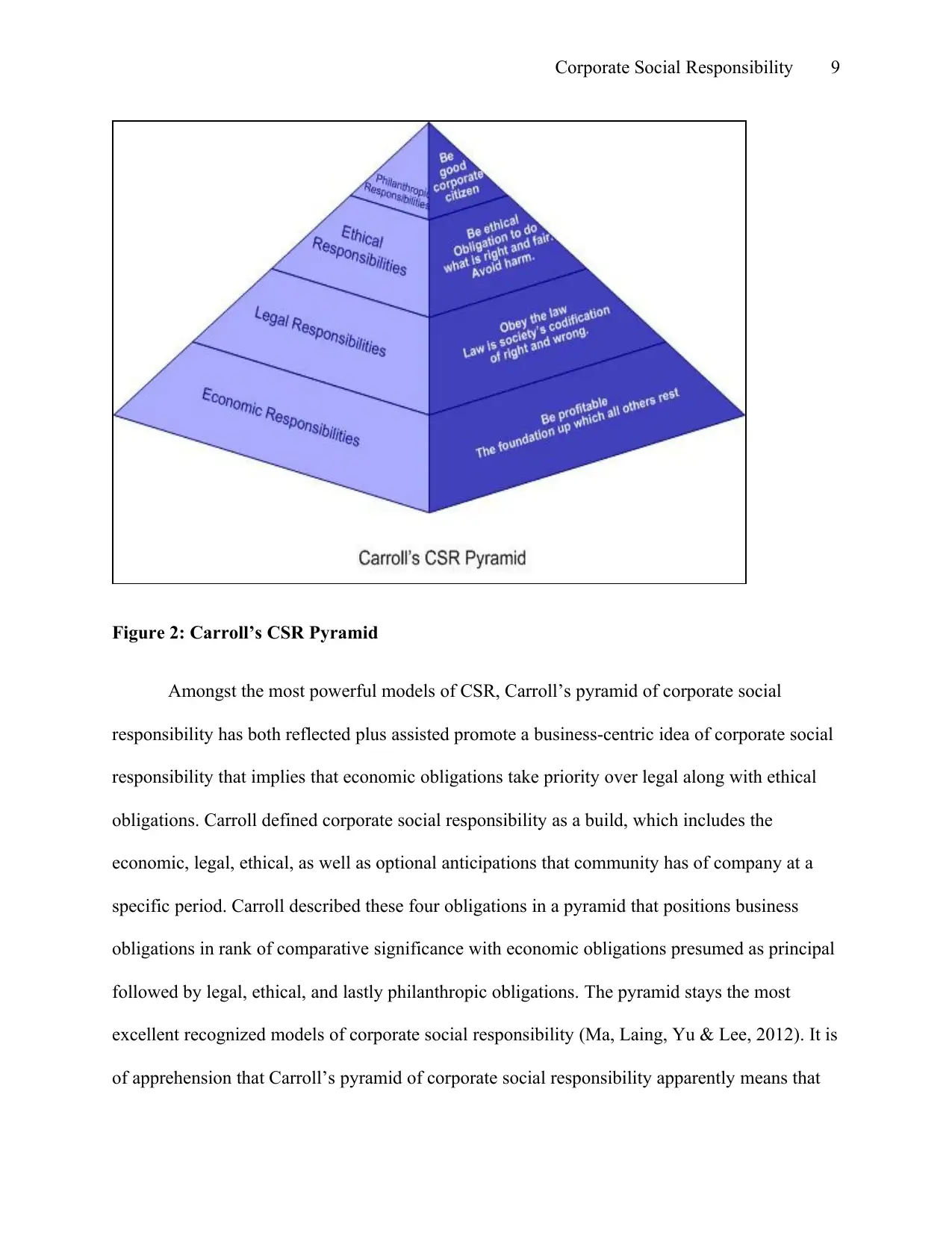
Corporate Social Responsibility 9
Figure 2: Carroll’s CSR Pyramid
Amongst the most powerful models of CSR, Carroll’s pyramid of corporate social
responsibility has both reflected plus assisted promote a business-centric idea of corporate social
responsibility that implies that economic obligations take priority over legal along with ethical
obligations. Carroll defined corporate social responsibility as a build, which includes the
economic, legal, ethical, as well as optional anticipations that community has of company at a
specific period. Carroll described these four obligations in a pyramid that positions business
obligations in rank of comparative significance with economic obligations presumed as principal
followed by legal, ethical, and lastly philanthropic obligations. The pyramid stays the most
excellent recognized models of corporate social responsibility (Ma, Laing, Yu & Lee, 2012). It is
of apprehension that Carroll’s pyramid of corporate social responsibility apparently means that
Figure 2: Carroll’s CSR Pyramid
Amongst the most powerful models of CSR, Carroll’s pyramid of corporate social
responsibility has both reflected plus assisted promote a business-centric idea of corporate social
responsibility that implies that economic obligations take priority over legal along with ethical
obligations. Carroll defined corporate social responsibility as a build, which includes the
economic, legal, ethical, as well as optional anticipations that community has of company at a
specific period. Carroll described these four obligations in a pyramid that positions business
obligations in rank of comparative significance with economic obligations presumed as principal
followed by legal, ethical, and lastly philanthropic obligations. The pyramid stays the most
excellent recognized models of corporate social responsibility (Ma, Laing, Yu & Lee, 2012). It is
of apprehension that Carroll’s pyramid of corporate social responsibility apparently means that
⊘ This is a preview!⊘
Do you want full access?
Subscribe today to unlock all pages.

Trusted by 1+ million students worldwide
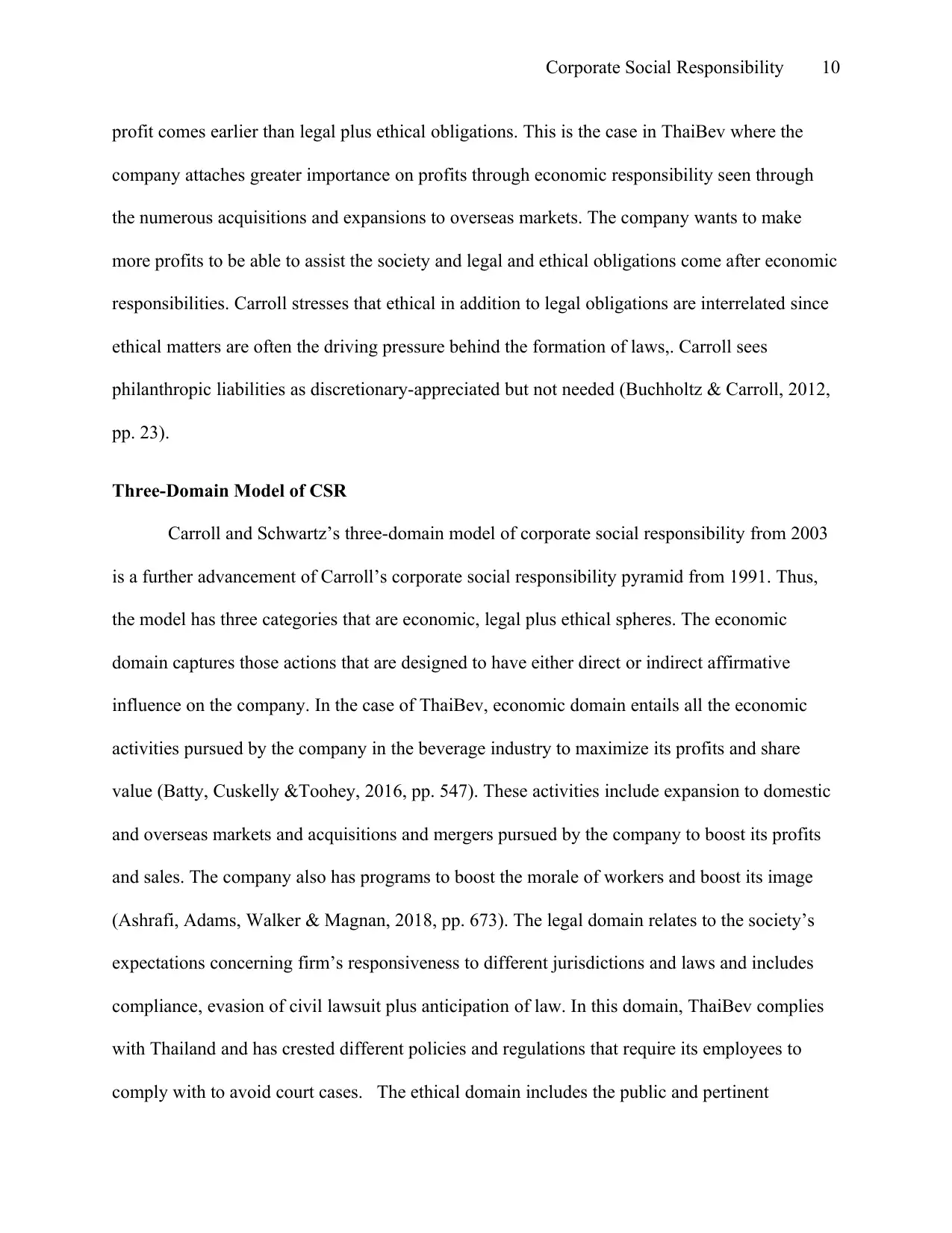
Corporate Social Responsibility 10
profit comes earlier than legal plus ethical obligations. This is the case in ThaiBev where the
company attaches greater importance on profits through economic responsibility seen through
the numerous acquisitions and expansions to overseas markets. The company wants to make
more profits to be able to assist the society and legal and ethical obligations come after economic
responsibilities. Carroll stresses that ethical in addition to legal obligations are interrelated since
ethical matters are often the driving pressure behind the formation of laws,. Carroll sees
philanthropic liabilities as discretionary-appreciated but not needed (Buchholtz & Carroll, 2012,
pp. 23).
Three-Domain Model of CSR
Carroll and Schwartz’s three-domain model of corporate social responsibility from 2003
is a further advancement of Carroll’s corporate social responsibility pyramid from 1991. Thus,
the model has three categories that are economic, legal plus ethical spheres. The economic
domain captures those actions that are designed to have either direct or indirect affirmative
influence on the company. In the case of ThaiBev, economic domain entails all the economic
activities pursued by the company in the beverage industry to maximize its profits and share
value (Batty, Cuskelly &Toohey, 2016, pp. 547). These activities include expansion to domestic
and overseas markets and acquisitions and mergers pursued by the company to boost its profits
and sales. The company also has programs to boost the morale of workers and boost its image
(Ashrafi, Adams, Walker & Magnan, 2018, pp. 673). The legal domain relates to the society’s
expectations concerning firm’s responsiveness to different jurisdictions and laws and includes
compliance, evasion of civil lawsuit plus anticipation of law. In this domain, ThaiBev complies
with Thailand and has crested different policies and regulations that require its employees to
comply with to avoid court cases. The ethical domain includes the public and pertinent
profit comes earlier than legal plus ethical obligations. This is the case in ThaiBev where the
company attaches greater importance on profits through economic responsibility seen through
the numerous acquisitions and expansions to overseas markets. The company wants to make
more profits to be able to assist the society and legal and ethical obligations come after economic
responsibilities. Carroll stresses that ethical in addition to legal obligations are interrelated since
ethical matters are often the driving pressure behind the formation of laws,. Carroll sees
philanthropic liabilities as discretionary-appreciated but not needed (Buchholtz & Carroll, 2012,
pp. 23).
Three-Domain Model of CSR
Carroll and Schwartz’s three-domain model of corporate social responsibility from 2003
is a further advancement of Carroll’s corporate social responsibility pyramid from 1991. Thus,
the model has three categories that are economic, legal plus ethical spheres. The economic
domain captures those actions that are designed to have either direct or indirect affirmative
influence on the company. In the case of ThaiBev, economic domain entails all the economic
activities pursued by the company in the beverage industry to maximize its profits and share
value (Batty, Cuskelly &Toohey, 2016, pp. 547). These activities include expansion to domestic
and overseas markets and acquisitions and mergers pursued by the company to boost its profits
and sales. The company also has programs to boost the morale of workers and boost its image
(Ashrafi, Adams, Walker & Magnan, 2018, pp. 673). The legal domain relates to the society’s
expectations concerning firm’s responsiveness to different jurisdictions and laws and includes
compliance, evasion of civil lawsuit plus anticipation of law. In this domain, ThaiBev complies
with Thailand and has crested different policies and regulations that require its employees to
comply with to avoid court cases. The ethical domain includes the public and pertinent
Paraphrase This Document
Need a fresh take? Get an instant paraphrase of this document with our AI Paraphraser

Corporate Social Responsibility 11
shareholders’ expectations concerning company’s ethical roles in both domestic and international
context. ThaiBev has been in the front line in ensuring that the company promotes ethical
practices in its operations both at home and overseas markets. The employees are encouraged to
promote ethical practices while handling the different tasks (Carroll, 2008, pp. 21).
Corporate Social Responsibility (CSR) Strategies
Social Responsibility
The conception of social responsibility is difficultly defined one by one because that
depend on the company’s reflection and responsibility, issues past the economic,
technological ,as well as legal needs of the company. So the company’s responsibility to assess
in the decision–making procedure the impacts on the outside social organization in a way, which
would achieve social gains along with the conventional economic, gain which the company
meets. This implies that social obligation starts where the law ends. To clarifying a company is
not being socially accountable if it simply adheres to the minimum requirement of the law due to
what any excellent citizen would do. The socially responsible firm recognizes this responsibility
and provides firm with complete and precise information and safe brands. Not only beyond the
recognition but also realize it has a responsibility to deal with social issues. For instance,
insuring a clean environment, discouraging drug use and teenage drinking, avoiding indirect
appeals to youth to smoke, and accounting for the inability of young children to evaluate
advertising and promotional appeals and some business take this issue to be part of their strategic
focus as well (Hrehová, 2019, pp. 106).
ThaiBev handles the business equals with truthfulness and equality. The company places
significance on supporting the operations of its distributors by offering information, advices, as
shareholders’ expectations concerning company’s ethical roles in both domestic and international
context. ThaiBev has been in the front line in ensuring that the company promotes ethical
practices in its operations both at home and overseas markets. The employees are encouraged to
promote ethical practices while handling the different tasks (Carroll, 2008, pp. 21).
Corporate Social Responsibility (CSR) Strategies
Social Responsibility
The conception of social responsibility is difficultly defined one by one because that
depend on the company’s reflection and responsibility, issues past the economic,
technological ,as well as legal needs of the company. So the company’s responsibility to assess
in the decision–making procedure the impacts on the outside social organization in a way, which
would achieve social gains along with the conventional economic, gain which the company
meets. This implies that social obligation starts where the law ends. To clarifying a company is
not being socially accountable if it simply adheres to the minimum requirement of the law due to
what any excellent citizen would do. The socially responsible firm recognizes this responsibility
and provides firm with complete and precise information and safe brands. Not only beyond the
recognition but also realize it has a responsibility to deal with social issues. For instance,
insuring a clean environment, discouraging drug use and teenage drinking, avoiding indirect
appeals to youth to smoke, and accounting for the inability of young children to evaluate
advertising and promotional appeals and some business take this issue to be part of their strategic
focus as well (Hrehová, 2019, pp. 106).
ThaiBev handles the business equals with truthfulness and equality. The company places
significance on supporting the operations of its distributors by offering information, advices, as

Corporate Social Responsibility 12
well as training sessions regularly. ThaiBev sees importance of giving back to the society
through its CSR programs. ThaiBev have tried to strongly implement many CSR programs and
activities related to corporate social responsibility approach, like offering instructional and
educational equipment to schools and universities joining PDA to launch village development
partnership program, change lover for the elderly, promoting nutrition of children in order to
associate closer with Thai people (Vukić, Omazić & Aleksić, 2019, pp. 336).
ThaiBev encourages workers from different firms, functions and nations that the
company is operating to expand job experiences, which are in line with the Talent Development
strategy. The company concentrates on proficiency improvement that entails Management
Competency, Functional Competency, as well as Leadership Competency. Thus, a
Transformational Program has been established to put in place workers with the correct beliefs
and awareness that prepared these employees for prospect transformations and make sure that the
firm will safeguard a competitive advantage that permits it to grow with constancy plus
responsibly. The company has constantly organized Talent Development Program with constant
change every year to make sure that it is well concerning the firm’s goals objectives. Part of the
Talent Development Program is founded on 70:20:10 learning strategy that encourages workers
to establish holistic business awareness plus enhance their leadership proficiency (Pedersen,
2010, pp. 157).
ThaiBev performs a survey on employee engagement on a yearly basis because the
company believes in the empowerment of its employees. The firm started to pursue the
assessment technique that was started by Aon Hewitt in 2016 to assess factors that affect
employees in six areas, which include company’s process, fundamental gains, and work
background, result of human capital engagement, leadership, as well as company’s standing. In
well as training sessions regularly. ThaiBev sees importance of giving back to the society
through its CSR programs. ThaiBev have tried to strongly implement many CSR programs and
activities related to corporate social responsibility approach, like offering instructional and
educational equipment to schools and universities joining PDA to launch village development
partnership program, change lover for the elderly, promoting nutrition of children in order to
associate closer with Thai people (Vukić, Omazić & Aleksić, 2019, pp. 336).
ThaiBev encourages workers from different firms, functions and nations that the
company is operating to expand job experiences, which are in line with the Talent Development
strategy. The company concentrates on proficiency improvement that entails Management
Competency, Functional Competency, as well as Leadership Competency. Thus, a
Transformational Program has been established to put in place workers with the correct beliefs
and awareness that prepared these employees for prospect transformations and make sure that the
firm will safeguard a competitive advantage that permits it to grow with constancy plus
responsibly. The company has constantly organized Talent Development Program with constant
change every year to make sure that it is well concerning the firm’s goals objectives. Part of the
Talent Development Program is founded on 70:20:10 learning strategy that encourages workers
to establish holistic business awareness plus enhance their leadership proficiency (Pedersen,
2010, pp. 157).
ThaiBev performs a survey on employee engagement on a yearly basis because the
company believes in the empowerment of its employees. The firm started to pursue the
assessment technique that was started by Aon Hewitt in 2016 to assess factors that affect
employees in six areas, which include company’s process, fundamental gains, and work
background, result of human capital engagement, leadership, as well as company’s standing. In
⊘ This is a preview!⊘
Do you want full access?
Subscribe today to unlock all pages.

Trusted by 1+ million students worldwide
1 out of 22
Related Documents
Your All-in-One AI-Powered Toolkit for Academic Success.
+13062052269
info@desklib.com
Available 24*7 on WhatsApp / Email
![[object Object]](/_next/static/media/star-bottom.7253800d.svg)
Unlock your academic potential
Copyright © 2020–2025 A2Z Services. All Rights Reserved. Developed and managed by ZUCOL.





